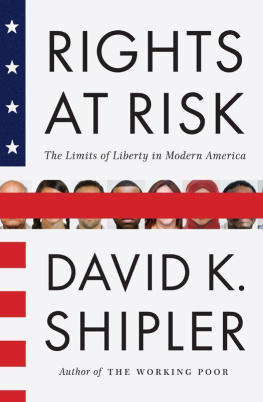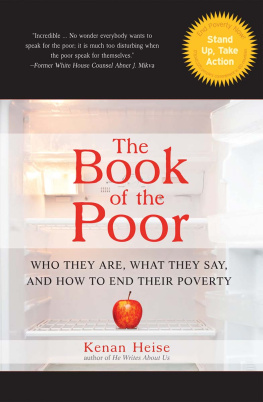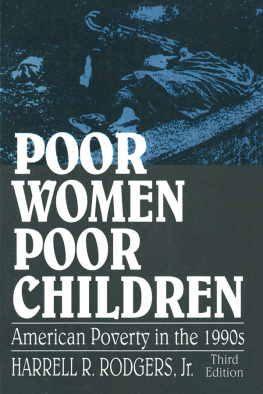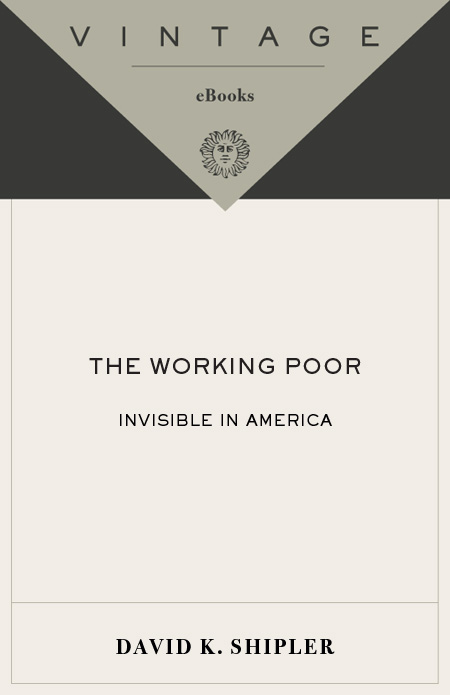
Acclaim for David K. Shiplers
THE WORKING POOR
Winner of the Myers Outstanding Book Award
Chosen as a Best Book of the Year by the San Francisco
Chronicle, The Washington Post Book World, and
San Jose Mercury News
Sprawling, compassionate. Describes with clear-eyed sympathy the individuals and families who sustain the seemingly limitless appetite for low-wage work and should provide ammunition to policy makersif there are anywho wish to seriously engage the project of eliminating poverty in America.
San Francisco Chronicle
In the tradition of Michael Harrington, Edward R. Murrow and more recently Barbara Ehrenreich as it seeks to alert a complacent nation about the misery and deprivation in its midst. By exposing the wretched condition of these invisible Americans, he has performed a noble and badly needed service.
The New York Times
Powerful. Some may find in this eye-opening book reason to demand change. Others, with regret perhaps, will see it as an accurate description of the inevitable costs of free market capitalism.
Los Angeles Times
Moving and meticulous. Unlike other sympathetic chroniclers of the working poor, he doesnt demonize their employers.
The Baltimore Sun
Masterly a series of memorable portraits.
The Hartford Courant
This urgent new book obliterates the notion that impoverished people are simply lazy. Shipler is a skilled interviewer whose knack for erasing himself from the picture lends this book anintimate quality.
Time Out New: York
Shiplers report is gripping, his characters more alive than those found in many novels.
Austin American-Statesman
Splendidly animated by Shiplers empathyhis ability to see people and more important to depict them, not as statistics or symbols of injustice, but as human beings.
The Miami Herald
The Working Poor will make any relatively well-off reader look at the struggles of the poor differently. [It] deserves a place on the American bookshelf next to Barbara Ehrenreichs Nickel and Dimed.
The Boston Globe
Shipler steers clear of diatribes, looking at human frailty and a spectrum of bosses and social services. With moving under statement, he develops a compassionate picture of the working poor.
The Star-Ledger (Newark)
A work of stunning scope and clarity. He brings the reader close enough to the challenges faced every day by his workers to make them feel it when the floor inevitably drops out beneath them.
The Buffalo News
The scope and importance of David Shiplers The Working Poor brings to mind Upton Sinclairs The Jungle.
Deseret News (Salt Lake City)
A powerful expos that builds from page to page, from one grim revelation to another, until you have no choice but to leap out of your armchair and strike a blow for economic justice.
Barbara Ehrenreich, author of Nickel and Dimed
There is no better book on poverty in America than The Working Poor because it describes in vivid detail the sort of day to day problems and the cycles that these folks are involved in really thought-provoking in a very important way.
Senator John Edwards
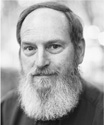
David K. Shipler
THE WORKING POOR
David K. Shipler worked for The New York Times from 1966 to 1988, reporting from New York, Saigon, Moscow, and Jerusalem before serving as chief diplomatic correspondent in Washington, D.C. He has also written for The New Yorker, The Washington Post, and the Los Angeles Times. He is the author of three other booksRussia: Broken Idols, Solemn Dreams; the Pulitzer Prize-winning Arab and Jew: Wounded Spirits in a Promised Land; and A Country of Strangers: Blacks and Whites in America. Mr. Shipler, who has been a guest scholar at the Brookings Institution and a senior associate at the Carnegie Endowment for International Peace, has taught at Princeton University, at American University in Washington, D.C, and at Dartmouth College. He lives in Chevy Chase, Maryland.
ALSO BY DAVID K. SHIPLER
Russia: Broken Idols, Solemn Dreams
Arab and Jew: Wounded Spirits in a Promised Land
A Country of Strangers: Blacks and Whites in America
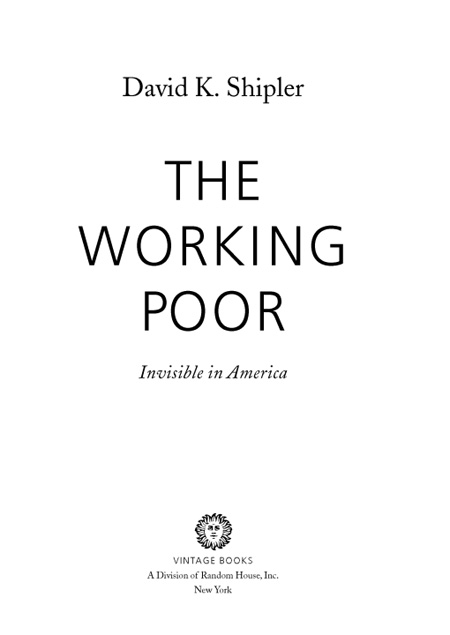
FOR DEBBY
Contents
Introduction
Chapter One
Chapter Two
Chapter Three
Chapter Four
Chapter Five
Chapter Six
Chapter Seven
Chapter Eight
Chapter Nine
Chapter Ten
Chapter Eleven
Authors Note
Most significant statistics have been updated in this edition. They show the basic landscape of poverty essentially unchanged, except that the contours of hardship have grown slightly more pronounced. Greater disparities of net worth separate the wealthiest and the poorest families, larger gaps in resources divide affluent school districts from others, more children miss school because of asthma, more Americans go without health insurance, more experience hunger, more are imprisoned, fewer workers are unionized, more illegal immigrants do essential jobs, and more of them die in the desert after crossing the border from Mexico.
Congress and many state legislatures have raised minimum wages, but they still leave most single-earner families below the poverty line. Astonishing percentages of adults who have been surveyed remain unable to perform everyday tasks in reading, math, and document comprehension, rendering them uncompetitive in a global marketplace. The subprime lending phenomenon, which began by exploiting low-income households, has reached into the middle class and jeopardized the entire web of financial markets, demonstrating that the ailments of the poor and the nearly poor cannot be quarantined. There is no refuge. There are only remedies.
D.K.S.
May 2012
Preface
Most of the people I write about in this book do not have the luxury of rage. They are caught in exhausting struggles. Their wages do not lift them far enough from poverty to improve their lives, and their lives, in turn, hold them back. The term by which they are usually described, working poor, should be an oxymoron. Nobody who works hard should be poor in America.
In 1997, as the countrys prosperity soared, I set out to find working people who had been left behind. I found them in black neighborhoods in Washington, D.C., and white towns in New Hampshire, in factories and job-training centers in Cleveland and Chicago, in housing projects in Akron and Los Angeles, in malnutrition clinics in Boston and Baltimore, in California sweatshops, and in North Carolina fields.
My purpose was to look into their lives as thoroughly as they would allow, to unravel the tangled strands of cause and effect that led to their individual predicaments. Some I encountered only once or twice, but others I have followed for five or six years into the present, checking with them again and again as the economic boom has collapsed and recession has set in, as they have gone through promotions and bankruptcies, marriage and divorce, childbirth and death in the family.


